While gardening can seem fleeting, perennials offer a lasting reward for your efforts. You’ve gotta pick hardy varieties, like peonies or daylilies, that match your climate and soil. Start by testing your soil’s drainage—aim for a mix that doesn’t hold water longer than 24 hours. Curious about the best planting depth or spacing for these tough plants? Stick around for the nitty-gritty tips to make your garden thrive.
Contents
Hardy Peony Varieties
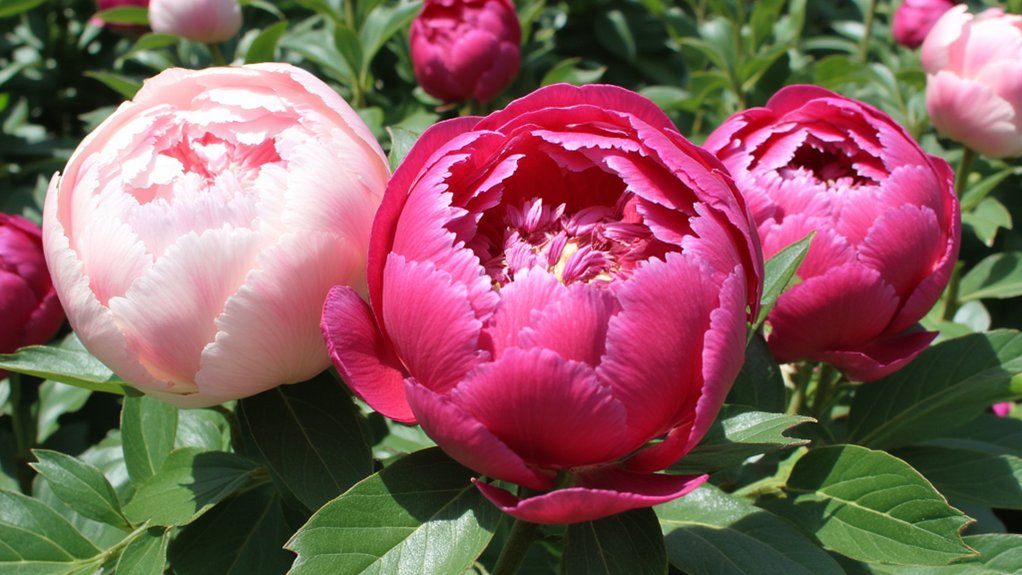
While peonies might seem tricky at first, let’s explore hardy peony varieties that can thrive in your garden. You’ve got options like the classic Paeonia lactiflora, known for its tough nature. It handles cold winters down to USDA Zone 3, so don’t worry about harsh frost.
Start by picking a spot with full sun, at least 6 hours daily, and well-drained soil. Dig a hole 2 feet wide and deep, spacing plants 3-4 feet apart for air flow. Add compost to enrich the soil, then plant the root with eyes—those pink buds—facing up, no deeper than 2 inches. Water thoroughly after planting, about 1 inch weekly, until established. These peonies bloom in late spring, usually May to June, rewarding your efforts with lush, vibrant flowers.
Stunning Itoh Peonies
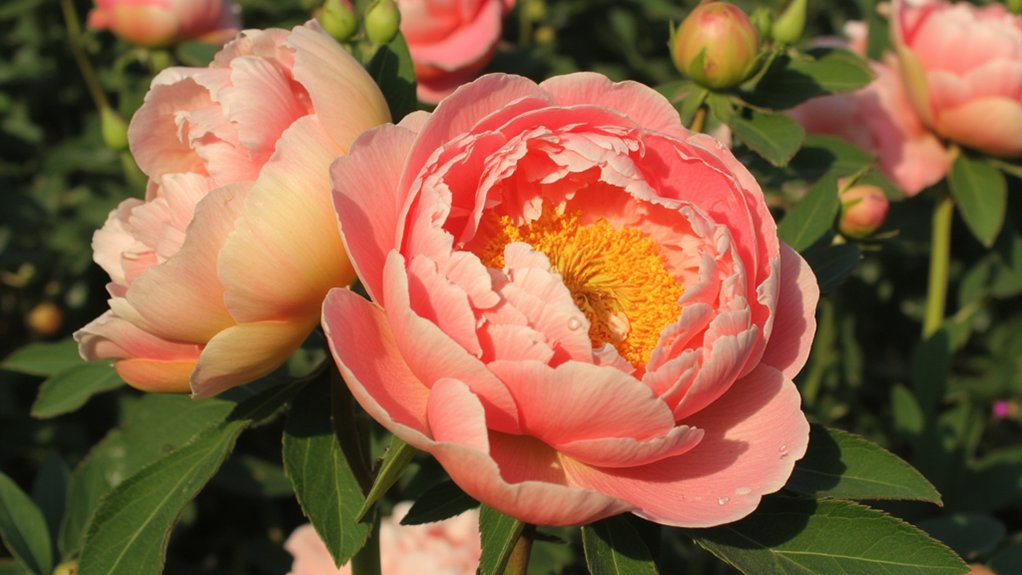
Let’s shift gears and talk about Stunning Itoh Peonies, a fantastic hybrid that blends the best of herbaceous and tree peonies. You’ll love their sturdy stems and lush, vibrant blooms. They’re a garden gem, combining durability with beauty.
Plant Itoh Peonies in fall, ideally September or October, in well-drained soil with full sun, about 6 hours daily. Dig a hole 18 inches deep and wide, mix in compost, then place the root so the eyes are 1-2 inches below soil level. Water thoroughly after planting, about 1 inch per week.
These peonies bloom late spring to early summer, offering huge, 6-8 inch flowers. Stake taller varieties, around 3 feet high, to prevent flopping. Keep weeds away, and you’re set for years of stunning color!
Vibrant Daylily Hybrids
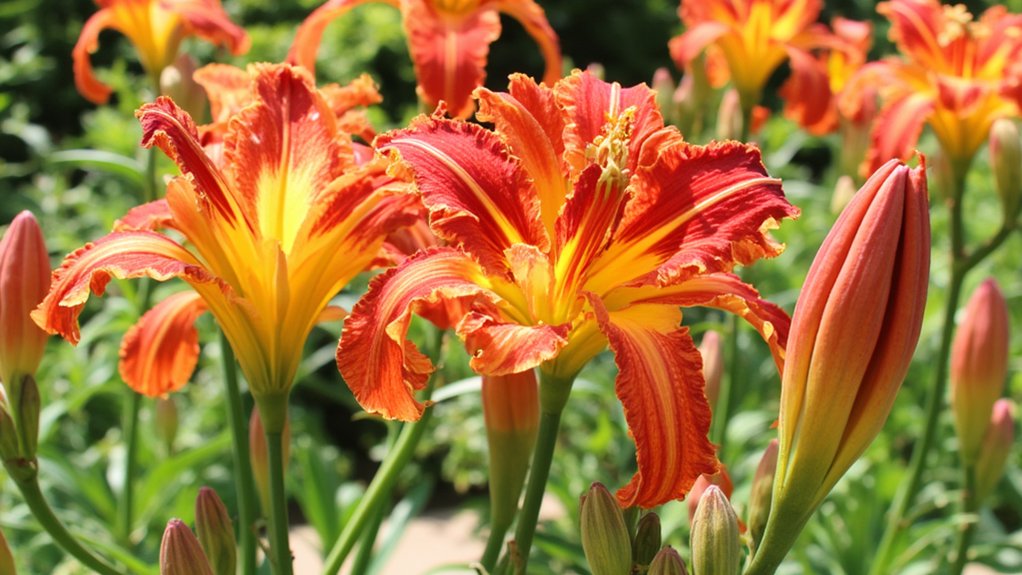
Dive right into the world of Vibrant Daylily Hybrids, a standout choice for any garden with their bold colors and easy care. You’ll love how these perennials brighten up any space with blooms in reds, yellows, and purples. They’re tough, too, thriving in most soils with little fuss.
Start by picking a sunny spot; daylilies need at least 6 hours of direct sunlight daily. Plant them in spring or fall, spacing tubers 18-24 inches apart, and dig holes about 12 inches deep. Add compost to enrich the soil, then water well after planting.
Keep ‘em moist, especially in the first month, watering every 2-3 days if it’s dry. Trim dead blooms to encourage more flowers. See, it’s that simple!
Classic Lavender Plants
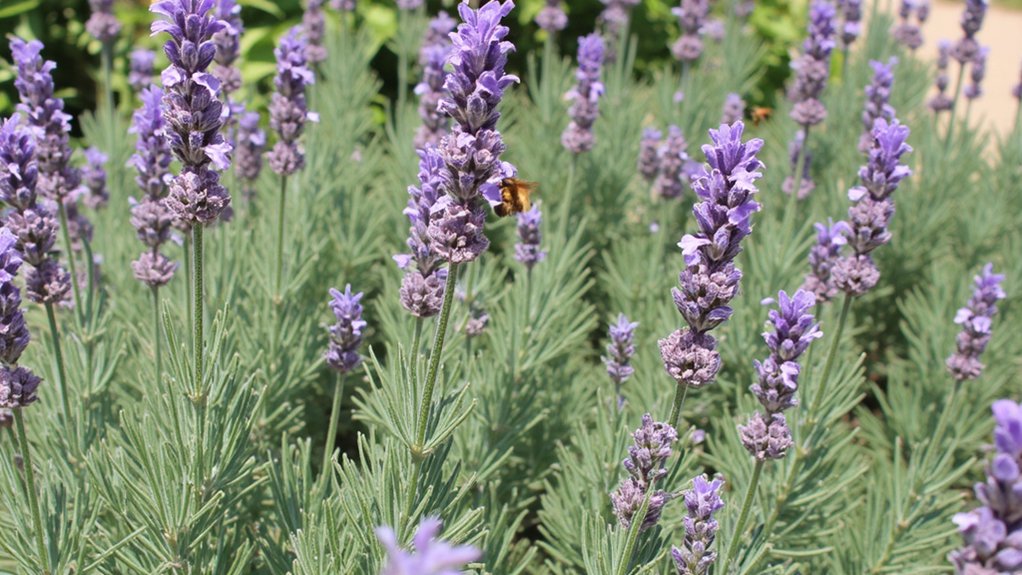
Hey there, check out Classic Lavender Plants, a timeless pick for adding subtle charm to your garden. These perennials aren’t just pretty; they’re tough, thriving for years with minimal fuss. Their silvery-green foliage and purple blooms bring a calming vibe.
Ready to plant? Choose a sunny spot with well-drained soil, ideally 6-8 hours of direct light daily. Space your lavender 12-18 inches apart, ensuring good air circulation to prevent rot. Water sparingly after planting, about once a week, until established.
Keep them happy by trimming spent flowers in late summer, roughly 2-3 inches above the base. This encourages bushier growth for next season. With sandy soil and full sun, you’ll have fragrant blooms from June to August, year after year.
Enduring Black-Eyed Susans
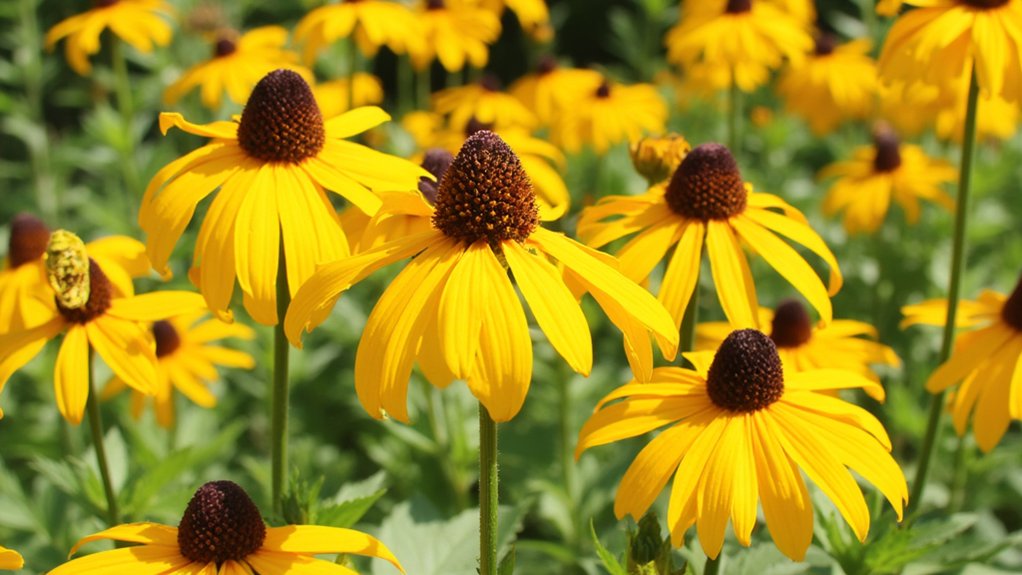
Moving from the soothing vibes of lavender, let’s chat about another garden favorite, Enduring Black-Eyed Susans. These tough perennials, known scientifically as Rudbeckia, brighten any yard with their golden petals and dark centers.
You’ll love how low-maintenance they are, thriving in full sun. Plant them in well-drained soil, spacing seeds or seedlings 12-18 inches apart, ideally in late spring. Water them weekly, about 1 inch deep, until they’re established—usually 6-8 weeks. After that, they’re drought-tolerant, so don’t fuss over them.
Deadhead spent blooms to encourage more flowers through summer into fall. They’ll grow 2-3 feet tall, perfect for borders or wildflower patches. Watch for powdery mildew; if it shows, trim affected leaves and improve air circulation pronto.
Resilient Coneflower Cultivars
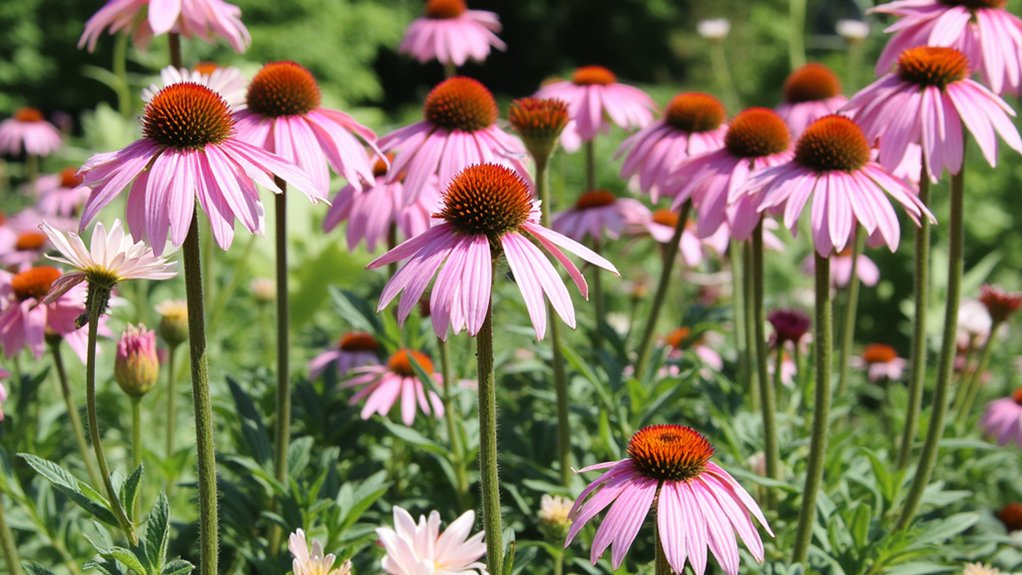
While Black-Eyed Susans steal the show with their golden glow, let’s shift to another hardy perennial, the Resilient Coneflower, or Echinacea. You’ll love how these tough plants thrive in tough conditions, often lasting years with minimal fuss. They’re perfect for sunny spots and well-drained soil, so pick a location wisely.
Start by planting Echinacea in spring or fall, spacing them about 18-24 inches apart. This gives roots room to spread. Water them deeply once a week, especially during the first season, to establish strong growth. They’ll reach 2-5 feet tall, depending on the cultivar, with vibrant blooms from June to August.
Don’t worry about pests; they’re naturally resistant. Just deadhead spent flowers to encourage more blooms, and you’re set for success!
Hardy Russian Sage

As we turn to another standout perennial, let’s explore Hardy Russian Sage, or Perovskia atriplicifolia. You’ll love how this tough plant adds airy, lavender-blue blooms to your garden. It thrives in full sun, so pick a spot with at least 6 hours of direct light daily.
Start by planting it in well-drained soil, ideally in spring or early fall. Space plants about 2-3 feet apart, since they can grow up to 4 feet tall and wide. Water moderately until established, roughly 1 inch per week, then cut back as it’s drought-tolerant.
Prune it in late winter, cutting back to 6-12 inches above ground. This keeps growth tidy and encourages fresh blooms. You’ve got this—Russian Sage is low-maintenance!
Tough Catmint Species

Let’s shift our focus to another rugged perennial, Tough Catmint Species, known scientifically as Nepeta. You’ll love how this plant thrives with minimal fuss, perfect for busy gardeners. It’s tough, drought-resistant, and blooms with vibrant purple-blue flowers from late spring to early fall.
Start by planting Nepeta in well-drained soil, ideally in full sun, though it tolerates partial shade. Space plants about 18-24 inches apart to allow air circulation, preventing mildew. Water moderately, about once a week, until established—roughly 6-8 weeks—then cut back since it handles dry spells well.
Deadhead spent blooms regularly to encourage more flowers. Every 2-3 years, divide clumps in early spring to keep them vigorous. With these steps, you’re set for years of hardy beauty!
Durable Sedum Varieties
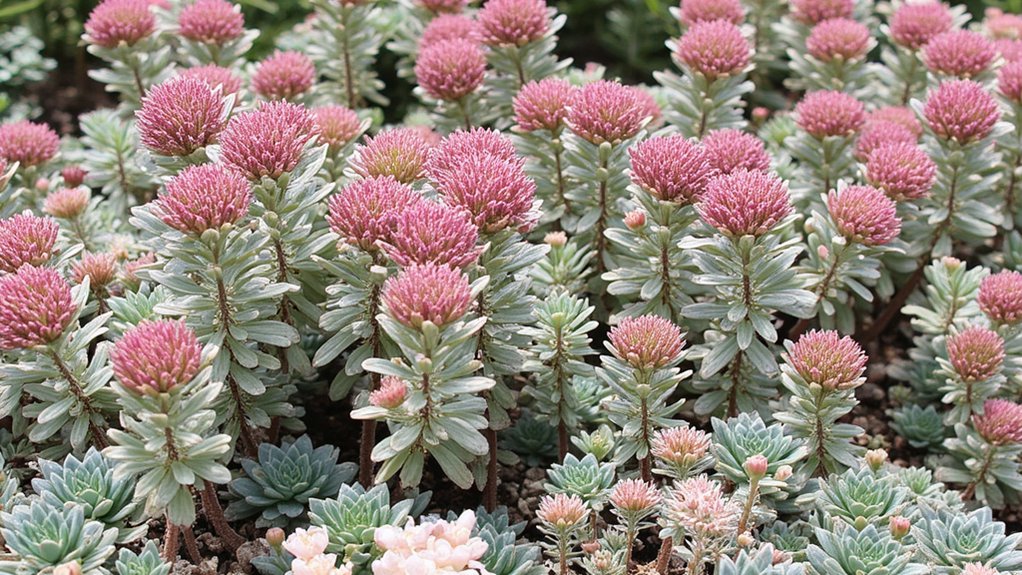
Check out the incredible world of Durable Sedum Varieties, often called stonecrop, for your garden’s next tough player. These succulents thrive in poor soil, resisting drought like champs. You’ll love how they handle full sun, needing minimal care.
Start by choosing varieties like Sedum ‘Autumn Joy’, which grows 18-24 inches tall, or ‘Dragon’s Blood’, a low 4-6 inch spreader. Plant them in well-drained soil, spacing 12-18 inches apart, ideally in spring. They’ll settle in fast, showing off fleshy leaves and star-shaped flowers by late summer.
Water sparingly, just enough to establish roots in the first 4-6 weeks. After that, they’re set for years, even in rocky spots. So, grab some sedums, plant ‘em, and watch your garden toughen up!
Reliable Hosta Selections
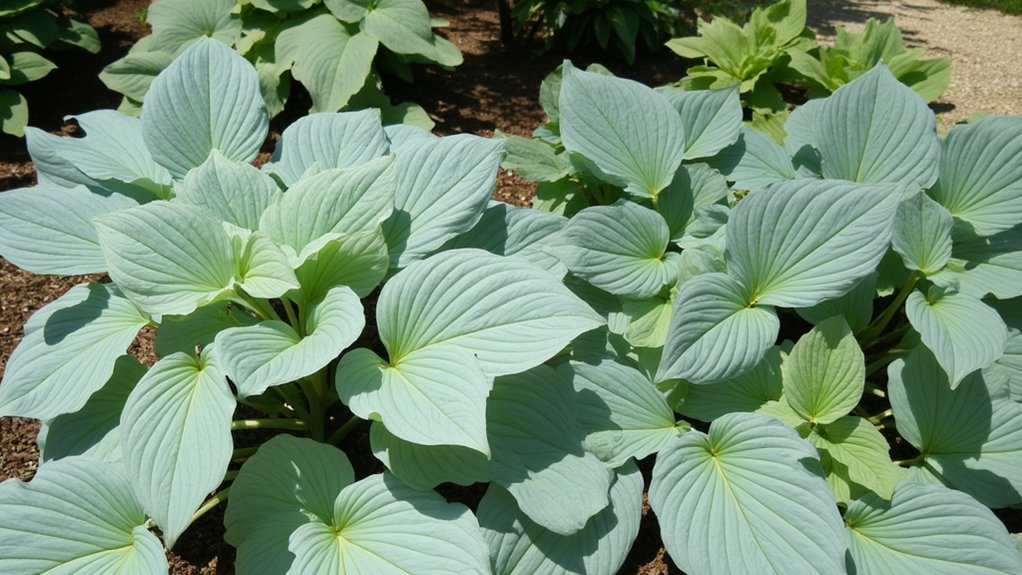
Switch your focus now from the rugged sedums to the dependable world of hostas, perfect for shady garden spots. You’ll love how these leafy perennials thrive under trees or in dim corners. They’re low-maintenance, but you’ve gotta pick the right ones.
Start with classics like Hosta ‘Blue Angel’, boasting huge, blue-green leaves, up to 16 inches long. Plant them in well-drained soil, spacing them 2-3 feet apart, and water weekly, about 1 inch deep, especially in dry spells. They’ll grow steadily, reaching full size in 3-5 years.
Don’t overlook ‘Sum and Substance’ for its giant, chartreuse foliage, ideal for brightening dark areas. Just watch for slugs—sprinkle diatomaceous earth around the base monthly to keep ‘em at bay. Stick with these, and your shade garden’s set!
